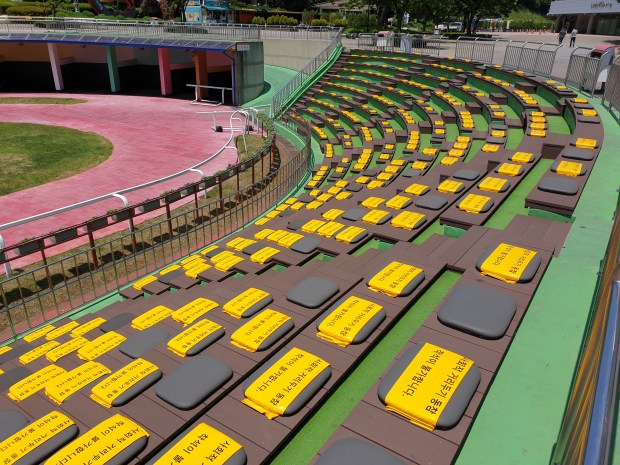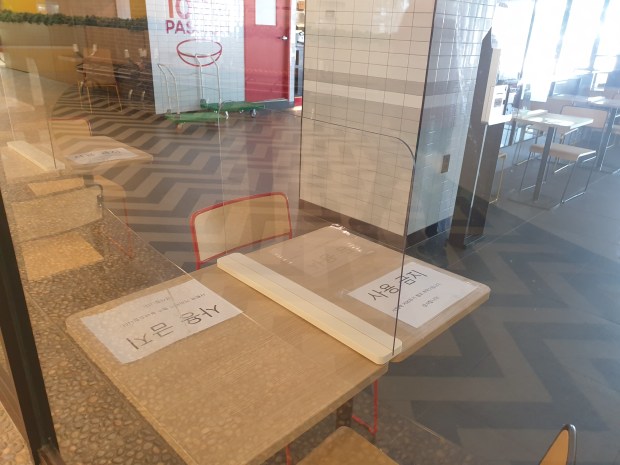Over three months since racing in Korea was forcibly halted by the spread in the country of the Covid-19 epidemic and with racing around the world gradually getting back up and running, there is still no confirmed date for resumption. Two weeks ago, the Ministry of Agriculture (under whose jurisdiction the Korea Racing Authority falls) approved plans to begin operations on May 29 with an attendance cap of 10% of the average number of racegoers. Shortly afterwards, a rise in confirmed Covid-19 “clusters” in the greater Seoul area, first at a Coupang distribution centre in Bucheon and then a group of churches in Incheon, caused the Korean government to urge caution in the Capital area up to and including June 14th and the approval was rescinded. That now means an earliest restart of June 19th and that is only if the number of new cases falls – right now it is hovering bewteen 30-50 per day.

A trial takes place at Seoul Racecourse during the shutdown – note the dividers by the rail for when racegoers finally return
One thing that does occasionally need to be made clear is that in Korea there has been no “lockdown” of any kind. Shops, restaurants, bars, cinemas, hair salons etc have all remained open throughout, albeit with some of them (cinemas especially) seeing a dramatic decline in business. The only things forced shut were sports venues and churches (schools were already closed for holidays, however it is only in the past two weeks that some pupils have returned to their desks). Churches and sports facilities reopened at the beginning of May while the country’s professional baseball and football leagues began behind closed doors.
Racing has also continued its operations. Trackwork has carried on as have official trials with up to ten heats a day being run at Seoul Racecourse on recent Thursdays and Fridays. Patience has generally been commendably high among participants, primarily due to a feeling of helplessness by all concerned. Everybody knows that racing can’t take place without punters on track because since 2009, there has been no facility for someone to have a legal bet from their home by telephone or on the internet, rendering racing behind closed doors for a sustained amount of time impossible.

Inside the grandstands, most seats have been blocked off
Racing in Korea operates under what is known as the “KRA Law” (a somewhat misleading title as the KRA itself often has little influence on its content) and this particular document contains plenty of ambiguities; the “maximum betting limit” being perhaps the best (or worst) example. Therefore, when it became clear there was a market – illegal services having sprung up in the early 2000s – the “KNetz” service was introduced to allow punters to place their bets without having to physically attend the racecourse or an OTB.
Just over a decade ago, a small number of politicians with a keen eye for a favourable headline, noticed that KNetz was therefore never formally legalised and launched a high profile campaign to get it shut down. As with many campaigns launched by publicity hungry politicians against publicity shy and quiet-life seeking civil servants, it was successful and in August 2009, KNetz was discontinued and live racing disappeared from local tv screens. In the years since, online gambling in Korea has thrived, just not of the legal kind – although the lottery, for some reason not seen as gambling, is allowed to sell tickets online – and Korea has become, along with Malaysia, the only major racing jurisdiction to be unable to offer its customers a safe and legal way of wagering from home.

It’s the same in the parade ruing with only one in four seats left open
Moves have been afoot over the past few years to rectify this. The KRA has launched its “My Card” app for punters to download and place bets on but it comes with the major catch that currently it only works when connected to the KRA wifi at a racecourse or OTB. It does mean, however, that once the political will is there, the infrastructure is ready to go immediately. Currently “My Card” accounts for approximately 30% of all turnover, a figure that is boosted by the fact that the popular Tierce (trifecta) bet type is available exclusively to punters on the app. Additionally the app features a league table for punters to find out how they match up against their peers as well as playing host to the annual Korea Handicapping Challenge, an event that prior to the shutdown, was this year set to be an official feeder contest for the Breeders’ Cup Betting Challenge in the US.
Politically, numerous parliamentary hearings have been held with figures such as Hong Kong Jockey Club CEO Winfried Engelbrecht Bresges among those who have made the trip to Yeouido over the years to impress upon lawmakers why a safe and legal avenue for online wagering is vital. Subsequently last November, a group of nineteen lawmakers led by Jeju Assembly member Kang Chang-il introduced the necessary legislation. It reached committee stage in February of this year, however it there ran into an impasse – the lack of “social concensus” – which could not be resolved before the dissolution of the 20th National Assembly in advance of April’s elections. As with all pending legislation it was therefore automatically abandoned.
The 21st National Assembly has just opened and it is essentially back to square one. Kang Chang-il didn’t run for re-election so the hope is that one of those eighteen others who put their name to the proposed bill, or a new lawmaker from an area such as Jeju that is heavily dependent on racing for jobs and tax revenue, will step up and re-introduce it. It is likely to happen but it will take time and it’s too late for it to have any mitigating impact on the current crisis.

Lotteria has installed dividers at its tables
So right now the only way of getting racing up and running is if at least some spectators are allowed into the venues. This would have happened on May 29th with the KBO baseball league also having been poised to allow spectators in from the same weekend before the new infections in the capital area were discovered and paralysis set in again. Lots of work has been done at the racecourses to enforce the idea of “social distancing” with even the Lotteria outlet in the grandstand having erected dividers at its tables – something it has not been required to do at its downtown locations. Temporary structures have been built by the rails to keep punters apart and three out of every four seats in the grandstand have been blocked off. Anyone who does attend will need to scan a QR code from their phone in to enable swift contact tracing in the event of a positive test by a racegoer or participant.
As it stands, it does seem as though racing in some form will return on Friday June 19th. Attendance will be very limited and how enough turnover can be generated to keep the whole show on the road long-term will be the next challenge. For now, for the sake of the whole industry, the only focus is on finding a way to get back racing.